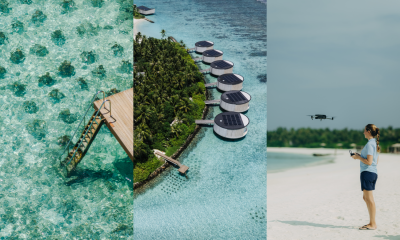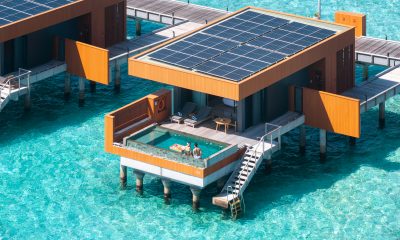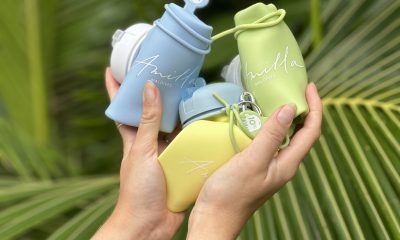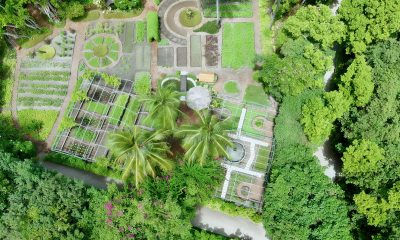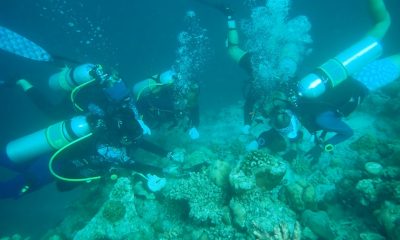Action
Coral colonies of hope: Gili Lankanfushi leads in coral preservation

At Gili Lankanfushi, a special Coral lines Project has been initiated to recover coral reefs. By growing small fragments of coral on hanging ropes (lines) and then transplanting them to the house reef near One Palm Island, the resort hopes to see regeneration and aim to kick start the health of the house reef.
The Coral Lines Project started three years ago and currently holds around 7484 coral colonies. Small fragments of coral are constantly being added to the already growing population on 153 lines.
The vulnerable nature of coral populations mean that they undergo cycles of disturbance and recovery. Gili Lankanfushi’s house reef was affected by warmer waters created by the El Nino event in 2016 which bleached much of the corals. Yet, against all odds, most fragments in the coral lines nursery survived. They have also been faced with a Crown of Thorns (coral predators) outbreak this year and have still remained intact. In some cases, corals in the lines are no longer present on shallow reefs in the area.
“Now, is the perfect time to begin stage two of the coral restoration project by moving coral from the nursery to the house reef. Transplanting coral is a delicate procedure with a lot of trial and error,” a blogpost post by Gili Lankanfushi’s marine team read.

Josie beginning the process. PHOTO/ GILI LANKANFUSHI
They began slowly by creating a test site with a small number of coral colonies to ensure healthy corals would not be lost unnecessarily. A site with conditions not too dissimilar to the nursery was identified. The area had to be flat and solid, with no loose material and space for growth. It also had to be an area that is easily accessible for monitoring, but nowhere in danger of tampering or accidental damage.
The team chose a depth of eight metres in the middle of house reef drop off where they regularly snorkel. Another major concern was the Crown of Thorns Starfish; so the corals were placed in an area visited regularly by Harvey, the Ocean Paradise Dive Centre manager, who has been removing these starfish from the reef for months.
The next step, according to the team, was to cut the colonies from the lines in the nursery, and transport them in mesh bags in the water. They decided to use three different Acropora species to begin with as they are fast growing and like a lot of light and a moderate current.

Clare cutting the coral from the line. PHOTO/ GILI LANKANFUSHI
Once at the site, the area of algae was cleaned and the coral attached to ensure protection from extreme water movement. The team placed the coral an equal distance apart to allow quick growth and attached the coral using epoxy, which is a clay like cement. They were aware from previous studies that Miliput (epoxy clay) kills the part of the coral it is attached to; so small amounts of putty were placed at the base of the coral.
Once a week, for a total of six weeks, the marine team will measure growth and survivorship of the coral. They hope to replicate the test at different depths and locations to find a suitable site to start a larger restoration project. But major transplantation works will be put on hold until after the monsoon season.
“Due to the fragility of coral species, our rehabilitation plans are very flexible, and subject to a long monitoring period. We expect to adapt our approach and long term management to ensure we keep up with the changing environment of the reef,” the post read.
“Previous restoration plans have been hindered by external threats, so we are so excited to finally begin this project. We will be producing scientific data along the way which we hope will contribute to current coral reef rehabilitation knowledge.”

Attaching the colonies using epoxy. PHOTO/ GILI LANKANFUSHI
Despite the transplants working well so far, the marine team says they still have many question to answer in the future. Are the corals on the house reef still reproducing? As these corals survived the last bleaching, will they be more genetically suited to future hostile conditions?
“The answers to these questions are all just a work in progress and we will have to keep on watching and learning as we replant and monitor these corals over the next few years. As our house reef sustained a lot of mortality and the coral cover is low, we hope that this new project will help to rejuvenate the reef and raise awareness,” the team concluded their post.
Meanwhile, Gili Lankanfushi is gearing up for the opening of its long awaited Marine Biology Centre, with a new marine biologist joining the island resort. Its resident Marine Biologist and Environmental Officer Deborah Burn and her assistant Josie Chandler will be replaced by Clare Baranowski, who will start her term by opening the long awaited Marine Biology Centre on World Oceans Day, which falls on June 8.
Set on the private island of Lankanfushi in the North Male Atoll, Gili Lankanfushi Maldives is an intimate coral island in a sparkling lagoon, with jetties threading across the water out to spacious villa accommodations, where ultimate privacy can be found. This luxury resort is just a 20-minute speedboat ride from the main Velana International Airport.
At Gili Lankanfushi, an idyllic personal hideaway is one of 45 spacious, rustic overwater villas crafted from natural wood and glass. A palette of sparkling blues paints the horizon, the ocean stretching to infinity wherever on the island. The open design, with indoor and outdoor living space, allows guests the freedom to be themselves, the sound of the sea and warm breeze soothing all senses.
Action
Denise Höfer returns to The Nautilus Maldives for four-day padel programme in March 2026

The Nautilus Maldives is set to welcome back Denise Höfer, Germany’s No. 1 padel player and a leading global ambassador of the sport, for a renewed edition of its Masters for Masters series, taking place from 25 to 28 March 2026. This four-day programme invites families, couples and players of every level to discover Padel as a joyful shared adventure, guided by one of the world’s most inspiring Padel athletes.
Padel has grown into a worldwide phenomenon, celebrated for its accessibility and its ability to bring people together. Fast, intuitive and inherently social, it is the perfect sport for parents and children, partners and friends. With its playful nature and quick learning curve, Padel creates rare moments where beginners and seasoned players can genuinely enjoy the game side by side.
In this spirit, The Nautilus presents a Padel Masterclass shaped by connection. Whether learning your first rally with your partner, watching your children gain confidence on the court, or joining a spirited group session with fellow travellers, the programme transforms play into an experience of shared joy and discovery.
Guests will train with Denise Höfer across a curated line up of classes. Tailored, on-demand experiences including Couples Escape, Family Fun, Cardio Padel and Padel × Wellness invite guests to hyper-personalise their journey, blending movement with mindfulness, and performance with light hearted enjoyment. Complimentary daily sessions feature a Group Masterclass and a Children’s Masterclass, each thoughtfully crafted to suit different learning styles and skill levels.
After energising mornings on the court, guests can retreat to Solasta Spa for treatments inspired by natural flow and deep release. Personalised massages, stretching rituals and ocean-influenced therapies provide a gentle counterbalance to the day’s activities, inviting both body and mind to settle into a state of restoration. The experience becomes a soothing rhythm of movement, rest and reconnection, perfectly aligned with the private island’s unhurried philosophy.
With just 26 ultra-luxury houses and residences in the Baa Atoll UNESCO Biosphere Reserve, The Nautilus offers the ideal setting for meaningful time together. Days unfold freely, guided not by schedules but by the simple desire to savour each moment. Whether learning a new skill as a family, sharing a playful match at sunset, or cheering one another from the sidelines, every experience becomes part of a memory shaped by spontaneity and warmth.
The Padel Masterclass with Denise Höfer invites guests to discover more than technique. It offers a chance to bond, to grow and to reconnect with the joy of learning something new together. At The Nautilus, this journey is shaped not by rules, but by the freedom to follow your own rhythm.
Denise Höfer, Germany’s No. 1 Padel Player, shares: “I’m thrilled to be returning to The Nautilus for this special edition of its Masters for Masters series. The Nautilus’s Padel court is truly one of my favourites in the world: it’s incredible setting and stunning lagoon views create an atmosphere unlike anywhere else. I can’t wait to share this unique experience with The Nautilus guests once again.”
Adan Gomez, General Manager of The Nautilus Maldives, adds: “We are delighted to welcome Denise Höfer back to our shores. Having an athlete of her talent and success return to our island is a true honour and offering our guests the rare opportunity to train with her makes this event genuinely exceptional.”
Event Details:
- Dates: 25 to 28 March 2026
- Location: The Nautilus Maldives
To learn more about Denise Höfer and this exclusive experience, please visit the resort’s website. To book your stay, please contact hello@thenautilusmaldives.com
Action
Siyam World achieves snorkelling world record with 307 participants

Siyam World Maldives has officially made global history. On December 5th, the island pulled off one of its boldest ideas yet, becoming the first resort on the planet to earn a Guinness World Records title for The Most People Snorkeling Simultaneously at a Single Venue. In partnership with Freedive Maldives, Siyam World rallied an incredible 307 snorkelers from guests, neighbors, and ocean lovers across the region, diving past the required 250 participant mark and turning the house reef into a spectacular sea of fins and fun. Guinness World Records officials flew in to verify every detail, and for the first time ever in the Maldives, every participant received an official Guinness World Records medal, making “Snorkel World 300” a milestone etched not only in record books but also in everyone’s memories.
The energy of the day embodied everything Siyam World stands for — a big, bold, anything-is-possible playground where imagination meets island life. The event was more than a record attempt; it was a celebration of marine life, community connection, and Siyam World’s adventurous DNA. The event aligned with Sun Siyam Resorts’ ongoing sustainability initiatives, encouraging guests and locals alike to appreciate and protect the natural beauty of the Maldives’ underwater world. It also served as a proud moment for the destination. As the first Guinness World Records medal ceremony ever held in the Maldives, the event spotlighted Maldivian hospitality, creativity, and ocean culture on a global stage.

“What a moment. Being the first resort in the world to set a Guinness World Records title is something we will always carry with pride, not just for Siyam World and Sun Siyam Resorts, but for the Maldives as well. We have never been the type to follow the usual path; doing the unexpected has always been our style. A huge thank you to everyone from the nearby islands who came together to make this possible,” said Ausy Waseem, Resort Manager, Siyam World.

If any resort was going to break a world record, it was always going to be Siyam World. From adrenaline-fueled adventures to quirky island experiences that spark global attention, Siyam World has earned its reputation as the Maldives’ most unrestrained, maximalist playground. This Guinness World Records title adds yet another chapter to its growing list of “only-at-Siyam” moments, proof that the resort is not just a place to stay, but a destination where the extraordinary is the everyday.
Siyam World now stands proudly as a Guinness World Records titleholder, an extraordinary accomplishment shared with the Maldives and the global travel community.
Featured
World-first overwater padel tennis court launched at Meyyafushi Maldives

Meyyafushi Maldives, a new five-star premium all-inclusive boutique resort, has introduced what it describes as a world-first in resort recreation: a fixed overwater padel tennis court. Positioned above clear lagoons and framed by sweeping sunset views, the court offers guests an opportunity to play and unwind in a distinctive setting surrounded by panoramic ocean vistas.
Located in the Lhaviyani Atoll, the overwater court allows players to take part in a match while immersed in the natural calm of the surrounding seascape. Guests staying at the resort are offered one hour of complimentary padel tennis as part of the premium all-inclusive package. The setting provides a secluded and tranquil space for both beginners and experienced players to practise with the sound of the ocean beneath.
“Padel tennis has become one of the fastest-growing sports in the world, and we wanted to bring it to life in the most spectacular way possible,” said Ahmed Siaar, Cluster General Manager of BeKind Hotels & Resorts. “Playing on water, surrounded by endless blues, transforms the game into something transcendent – it’s active luxury at its finest.”
The overwater court forms part of Meyyafushi’s wider range of facilities, which include an underwater dining restaurant, an overwater wine cellar, water pool suites with slides, a mini bowling lane, and an adults-only sky bar featuring a glass-bottom infinity pool. Each facility has been created to offer experiences that encourage connection, exploration and wellbeing.
With uninterrupted sunset views and a distinctive overwater location, Meyyafushi Maldives’ padel tennis court marks a global first for the sport, bringing together physical activity, landscape and design in a single setting.
-

 Drink1 week ago
Drink1 week agoFelice Capasso brings award-winning mixology to The St. Regis Maldives Vommuli this February
-
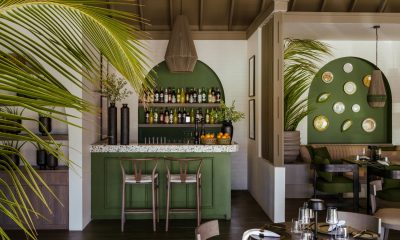
 Drink1 week ago
Drink1 week agoSun Siyam Olhuveli unveils Milano, Olive Bar and Crust & Flame on Dream Island
-
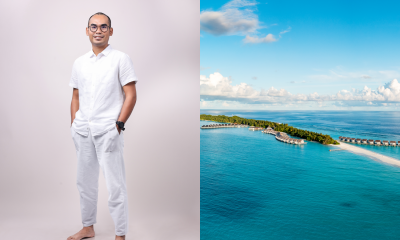
 Featured1 week ago
Featured1 week agoKuramathi Maldives announces private wellness programmes with Imron Zulfikar
-

 Entertainment1 week ago
Entertainment1 week agoHulhule Island Hotel names 2ofus as New Year’s Eve 2026 headline act
-
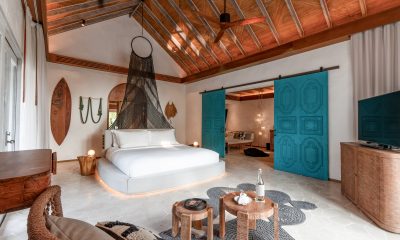
 Featured1 week ago
Featured1 week agoSpring reawakens: Sirru Fen Fushi showcases Maldives at its calmest
-

 Cooking5 days ago
Cooking5 days agoThe St. Regis Maldives Vommuli Resort welcomes Chef Renzi Gianluca for Tastemaker series collaboration
-

 Cooking1 week ago
Cooking1 week agoChef Frank Fol leads plant-based culinary programme at ananea Madivaru Maldives
-
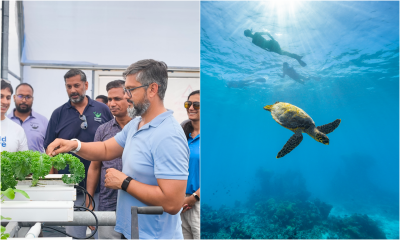
 News1 week ago
News1 week agoThe Standard, Maldives achieves Green Globe Certification after rigorous audit





